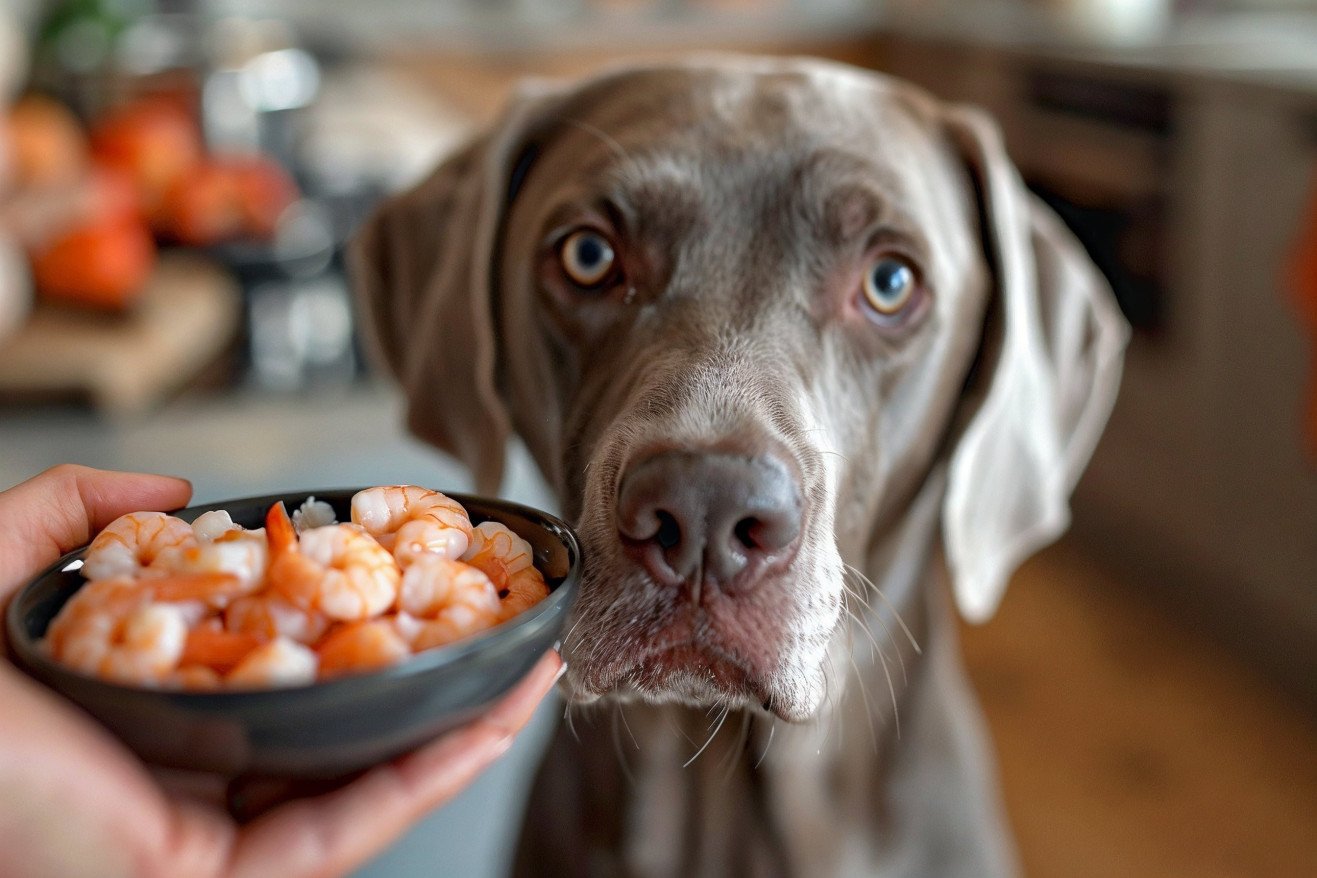Can Dogs Eat Shrimp? How to Safely Share This Seafood
2 March 2024 • Updated 2 March 2024

Shrimp is a nutritious food for people, but that may leave you wondering if it’s safe for dogs to eat. The answer is yes, dogs can eat shrimp, but there are some important things to keep in mind. Shrimp needs to be cooked to kill bacteria and other pathogens and served without the shells to avoid a choking hazard.
While shrimp can provide dogs with lots of important nutrients, including protein, it’s best to think of it as a special treat.
To thoroughly cover the ins and outs of feeding shrimp to dogs, we’ll look at a range of studies from the fields of veterinary nutrition, food science, and dog nutrition. We’ll cover how the dog digestive system deals with seafood, the potential health benefits of shrimp for dogs, and how to make sure shrimp is safe for dogs to eat.
Our goal is to provide a thorough overview that will help you decide whether or not to add shrimp to your dog’s diet.
Can dogs eat shrimp?
Understanding the Nutritional Value of Shrimp for Dogs
Shrimp is packed with nutrients that can benefit dogs. According to Healthline, a 3-ounce serving of shrimp contains 20.4 grams of protein, which is important for muscle and overall growth in dogs. Shrimp also contains a variety of vitamins and minerals, including phosphorus, which is important for bone health, iron, which helps transport oxygen in the blood, and zinc, which supports the immune system.
In addition, the antioxidant astaxanthin found in shrimp has been shown to support heart and brain health in dogs.
That said, the cholesterol and sodium in shrimp are cause for concern. Shrimp contains 161 mg of cholesterol per serving, which is relatively high and could be problematic for dogs with certain health conditions.
In addition, the 94.4 mg of sodium per serving in shrimp could be dangerous for dogs that are on a low-sodium diet. As a result, VeryWellFit explains that the potential risks of cholesterol and sodium need to be weighed against the benefits of the nutrients in shrimp.
As a result, the amount of shrimp a dog can eat should be based on the dog’s size and health status and should be tailored to the individual dog. It’s important to feed shrimp in moderation, and while shrimp can be a healthy addition to a dog’s diet, it’s important to consult a veterinarian to determine the right amount and frequency to feed your dog to ensure a well-rounded diet.
Dealing With Seafood Allergies in Dogs
While seafood can be a delicious addition to your dog’s diet, it’s important to watch for allergies, which are less common than other types of allergies but still possible. Signs of an allergic reaction to food in dogs include itching, vomiting, and diarrhea. The American Kennel Club explains that true food allergies can cause an immediate, potentially severe immunological response, while food sensitivities can cause chronic problems without an immunological response.
Seafood allergies in dogs are less common than allergies to more common proteins like chicken or beef, but they do happen. According to the Clinical Nutrition Service at Cummings School, the only way to definitively diagnose a food allergy is through an elimination diet that’s done under the supervision of a veterinarian.
If your dog shows signs of an allergic reaction after eating shrimp, take them to the vet right away. The vet can diagnose the issue and recommend a course of action, which may include an elimination diet to determine the specific allergen.
Knowing what your dog can and can’t eat is important for their overall health and well-being. By knowing the signs of food allergies and getting them treated, you can make sure your dog stays healthy and happy and can continue to eat a wide variety of foods without any issues.
How to Make a Dog-Safe Shrimp Dinner
To make sure your dog can safely eat shrimp, it’s important to start with the right preparation. Healthy Paws notes that cooking shrimp thoroughly is important to kill off any bacteria and pathogens that could cause shellfish toxicity. Not only does cooking ensure that the shrimp is safe for your dog to eat, but it also helps make sure that the shrimp’s nutrients, like omega-3 fatty acids and vitamins, are preserved.
When preparing shrimp for dogs, the first step is to remove any inedible parts, including the shells and tails, as recommended by PetMD. This is important to prevent choking and blockages in your dog’s digestive system.
Then, choose a cooking method that doesn’t add any unhealthy extras to the shrimp; Healthy Paws recommends steaming as the best way to cook shrimp for your dog because it doesn’t require the use of oil or seasonings and won’t compromise the shrimp’s nutritional value.
Introduce shrimp to your dog’s diet slowly and watch for any signs of an upset stomach or an allergic reaction. A small, plain cooked shrimp can be given as a special treat in moderation if you follow the dietary recommendations from PetMD and Daily Paws. If you do this, you can make sure that your dog has a safe and tasty seafood experience.
How the Canine Digestive System Works
One of the most important factors to consider when thinking about how dogs digest shrimp is the canine digestive system. According to Pet Honesty, a dog’s digestive system is made up of several different specialized parts that work together to digest food.
The stomach, for example, acts as a holding tank and pre-digests food for a long period of time, unlike the human stomach. The small intestine, which is much longer than the dog’s large intestine, is where the majority of digestion and nutrient absorption takes place.
As shrimp moves through these different parts of the digestive system, it is broken down by the digestive enzymes and acids in the stomach. According to PetMD, dogs have a faster digestive system than humans, and it takes about six to eight hours for food to move through the entire system. This faster digestive system is well-suited to digesting the protein in shrimp and making the most of its nutritional value.
While shrimp is high in cholesterol and sodium, these are not as much of a concern for dogs as they are for humans. Dr. Joseph Wakshlag from the University of Florida College of Veterinary Medicine explains that cholesterol has a different impact on dogs than it does on humans. As a result, the cholesterol in shrimp is not as much of a concern for dogs.
However, it’s still important to watch a dog’s sodium intake, especially if they have other health issues that require them to limit the amount of sodium they consume.
Research from the veterinary community has shown that the canine digestive system is highly adaptable, including when it comes to digesting seafood. By being mindful of portion sizes and a dog’s specific health needs, shrimp can be a safe and occasional part of a dog’s diet.
Dishing Out Shrimp: A Tail-Wagging Delight in Moderation
Throughout our exploration of understanding the dos and don’ts of giving dogs shrimp, the one consistent takeaway is the importance of balance. If shrimp is cooked and prepared properly (i.e., without shells and tails), it can be a nutritious treat that’s full of protein and other important nutrients that can help our dogs.
However, it’s also important to be mindful of the cholesterol and sodium levels that shrimp contains, which is why it’s important to feed it to dogs in moderation.
We’ve also come to understand that it’s important to take into account any health issues or dietary restrictions that may impact the decision to add shrimp to a dog’s diet. This is why it’s so important to have a good relationship with a vet, who can help you figure out the right amounts and frequency for your dog.
In short, shrimp can be a part of a dog’s diet, but it should be introduced slowly and fed in moderation as an occasional treat rather than a regular part of a dog’s diet.
By making sure to prioritize safety and pay close attention to your dog’s individual needs, shrimp can be a way to add some variety to a dog’s diet without causing any negative health impacts. Use this as a reference to make sure you’re feeding your dog the best and most enjoyable seafood treats.


